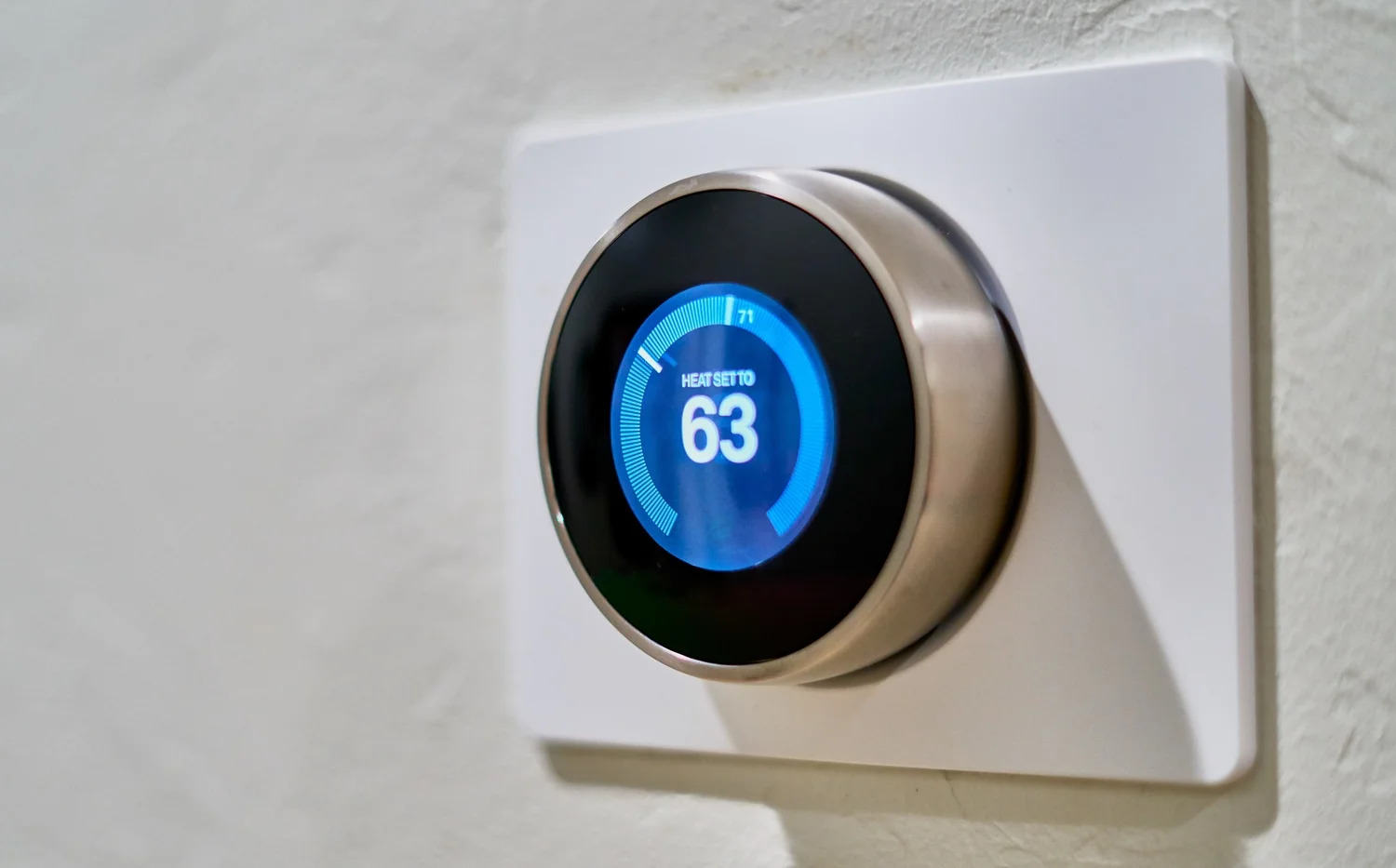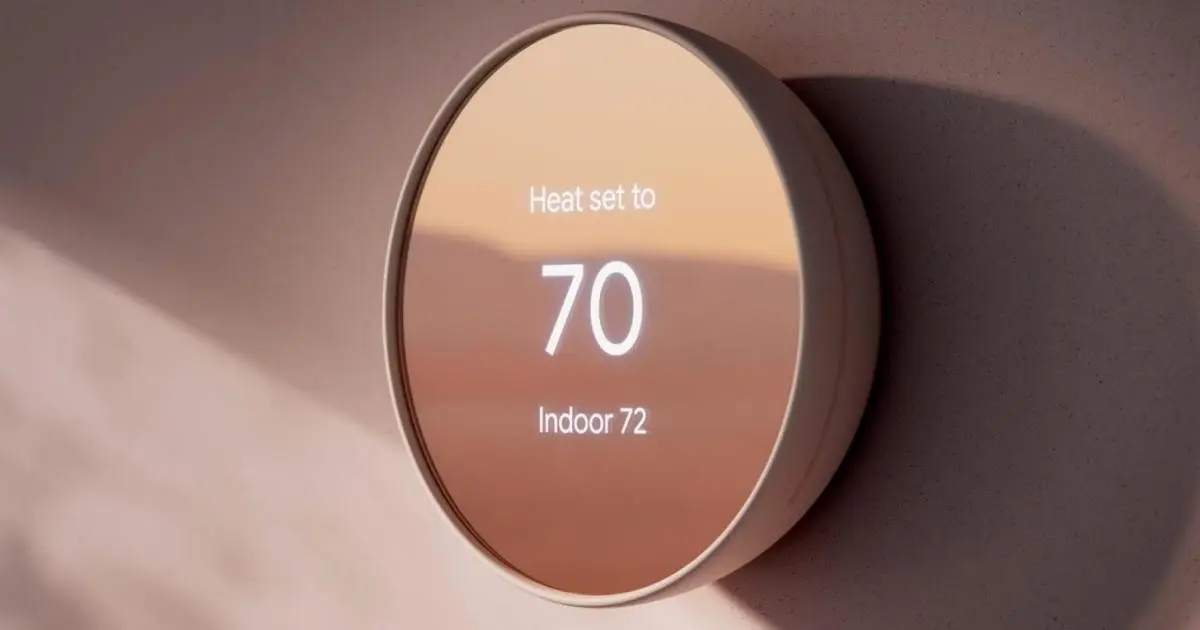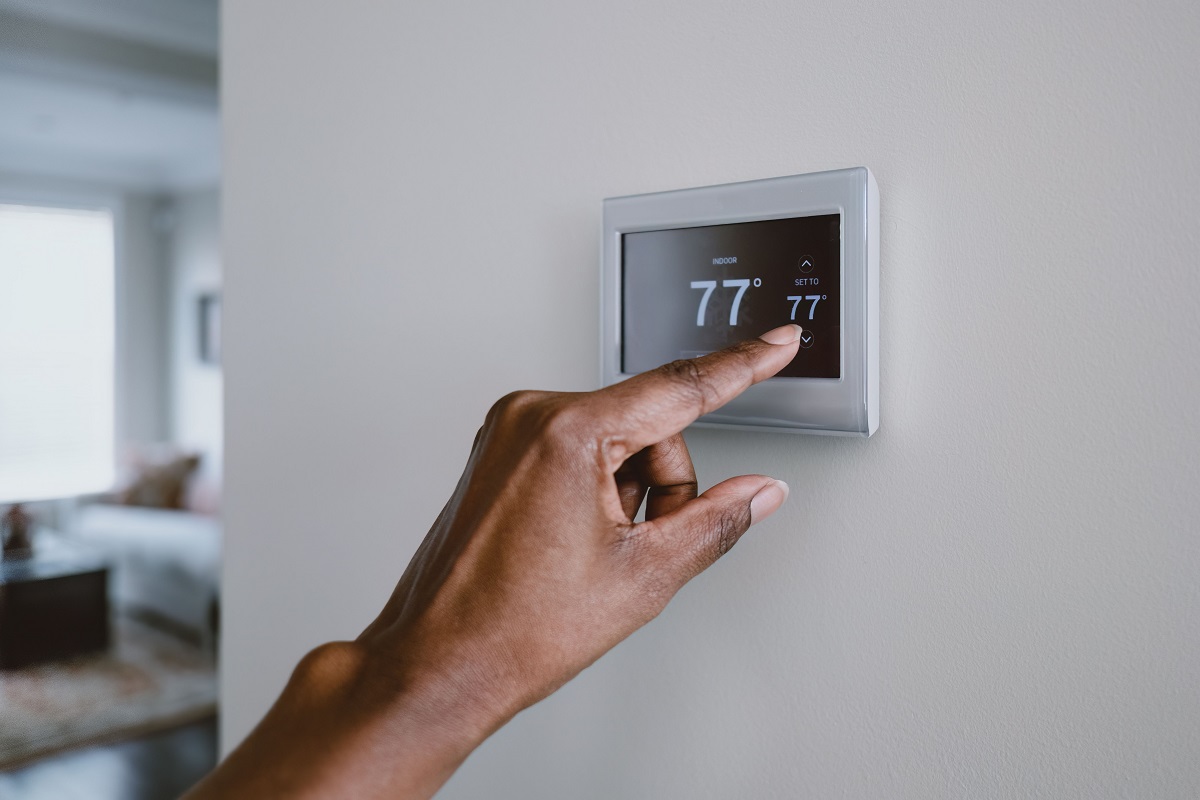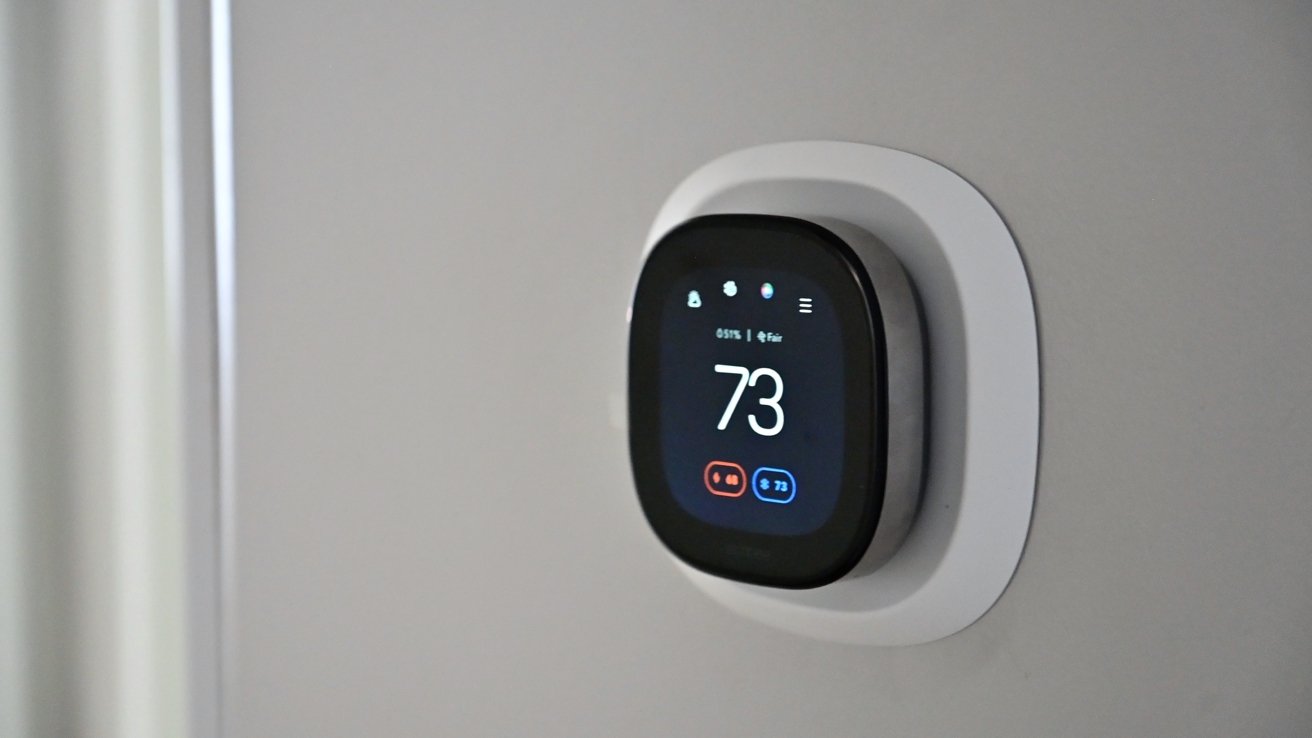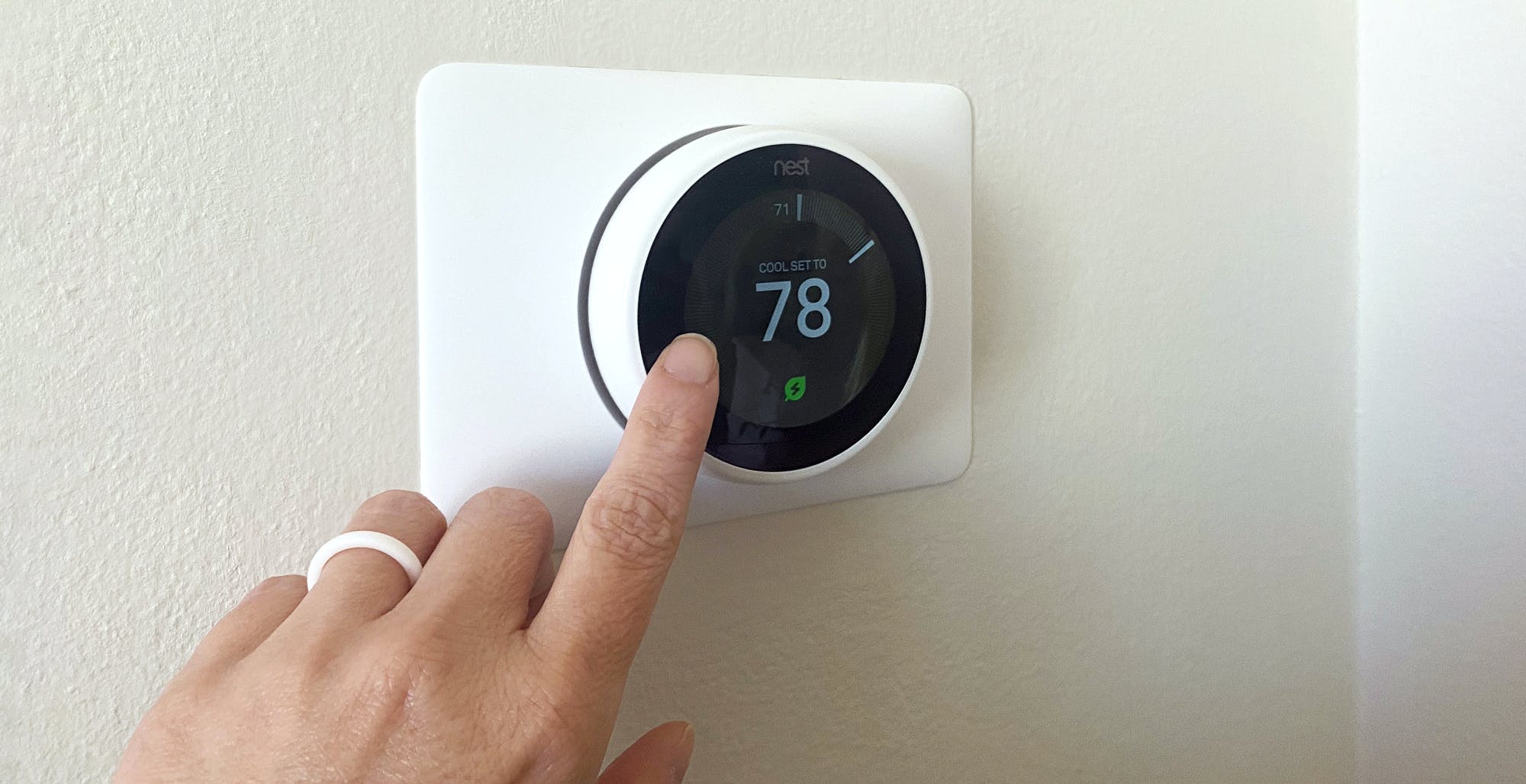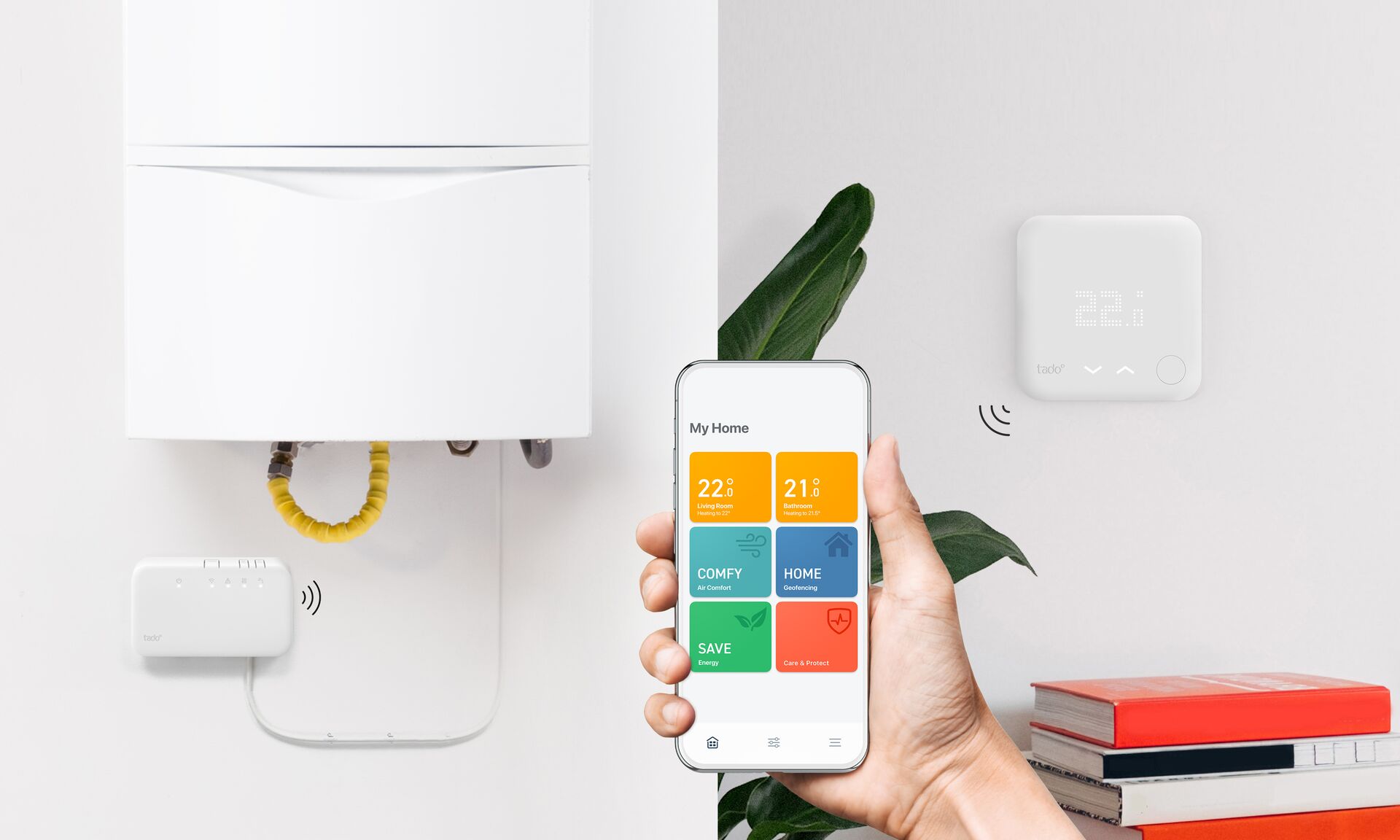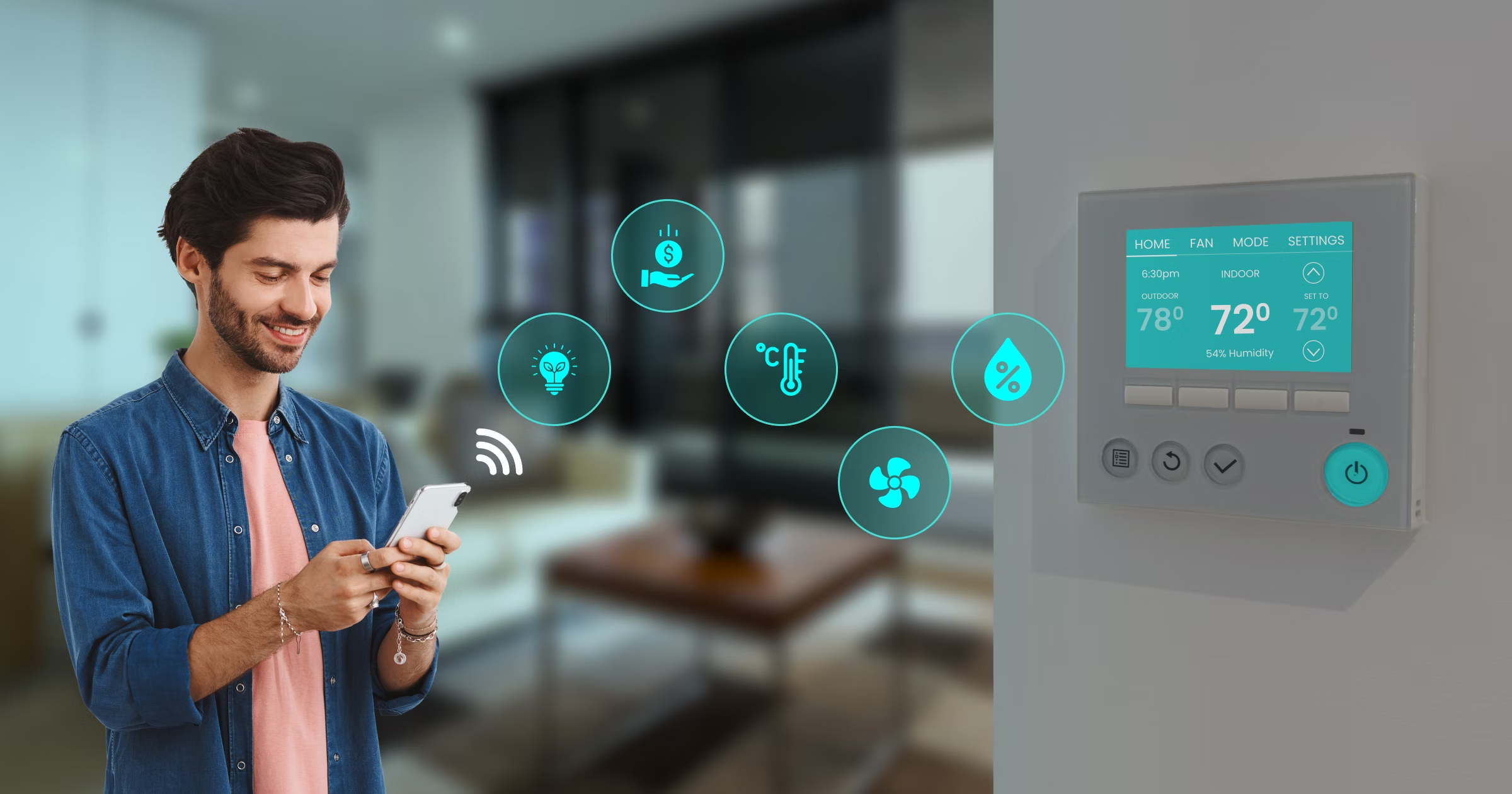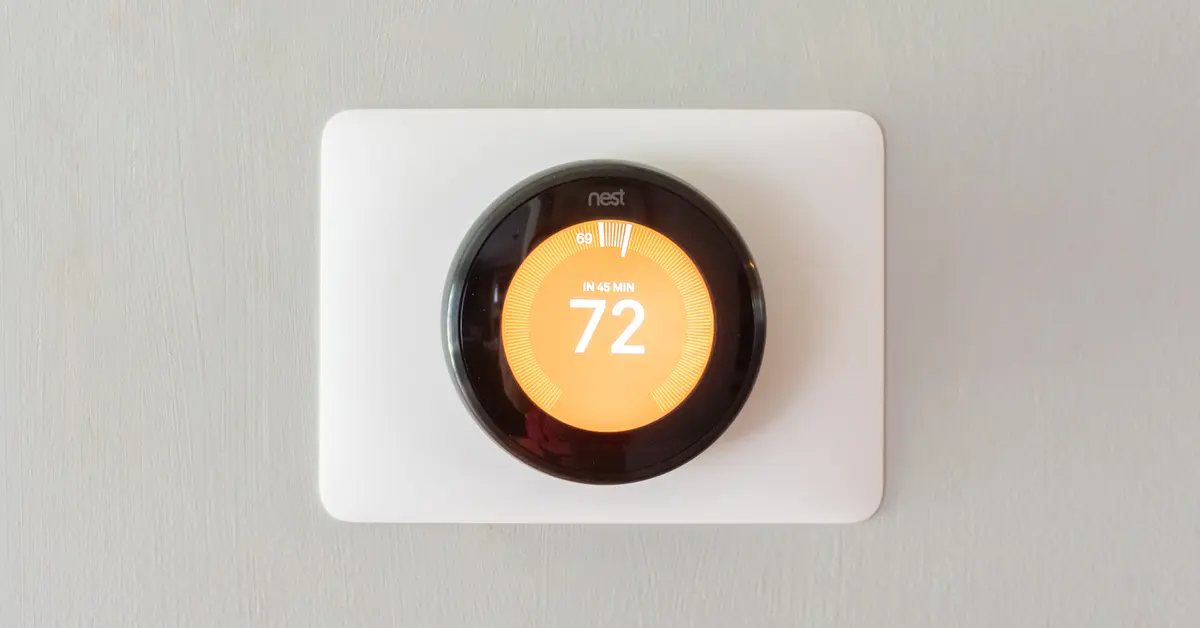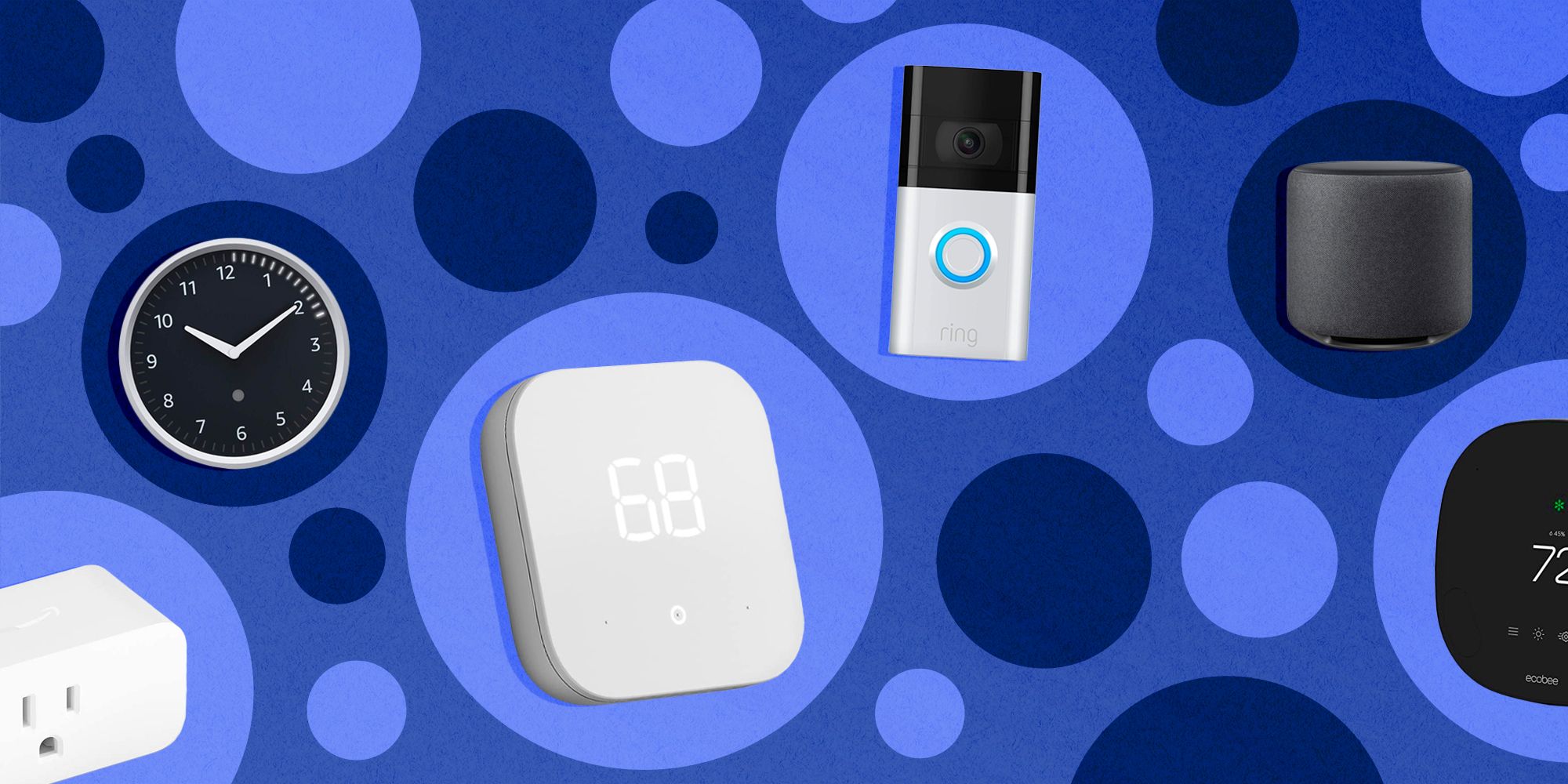Introduction
Welcome to the world of smart thermostats! These innovative devices have gained popularity in recent years, offering homeowners a more convenient and efficient way to control their heating and cooling systems. If you’re wondering how smart thermostats can save energy and reduce your utility bills, you’re in the right place.
A smart thermostat is an advanced temperature control device that connects to your HVAC (Heating, Ventilation, and Air Conditioning) system and allows you to remotely manage and automate your home’s heating and cooling settings. Unlike traditional thermostats, which require manual adjustments, smart thermostats utilize cutting-edge technology to learn your preferences, adapt to your schedule, and optimize energy usage.
In this article, we will explore how smart thermostats work, the benefits they offer, and most importantly, how they can significantly contribute to energy savings in your home. By taking advantage of the features and capabilities of smart thermostats, you can create a more comfortable living environment while minimizing energy waste.
As energy efficiency becomes increasingly important in our daily lives, smart thermostats have emerged as a valuable tool for homeowners and the environment. These devices not only provide convenience and comfort, but they also play a crucial role in reducing greenhouse gas emissions and promoting sustainability.
So, whether you’re considering upgrading to a smart thermostat or are simply curious about their efficiency capabilities, keep reading to discover how these intelligent devices can help you take control of your energy consumption.
What is a smart thermostat?
A smart thermostat is a cutting-edge device that replaces traditional thermostats in your home. These advanced temperature control systems utilize Wi-Fi connectivity and intelligent algorithms to provide precise control over your heating and cooling settings. Smart thermostats offer a range of features and capabilities that go beyond the basic functions of regular thermostats, allowing you to optimize energy usage, improve comfort, and save money on your utility bills.
One of the key features of a smart thermostat is its ability to connect to the internet, enabling you to remotely monitor and control your home’s temperature settings. Through a dedicated mobile app or a web portal, you can adjust the temperature even when you’re away from home, ensuring that your living space is comfortable when you arrive.
Furthermore, smart thermostats go beyond simple temperature control. They incorporate advanced sensors and algorithms to learn your behavior patterns, preferences, and schedule. By analyzing data such as occupancy, weather conditions, and user inputs, smart thermostats can automatically adjust the temperature settings to maximize comfort and energy efficiency.
Some smart thermostats also offer additional features such as humidity monitoring, air quality tracking, and integration with other smart home devices. These features allow for a more holistic approach to home comfort and energy management.
In terms of compatibility, most smart thermostats are designed to work with a wide range of HVAC systems, including central heating and cooling systems, heat pumps, and even radiant heating systems. Before purchasing a smart thermostat, it’s important to ensure compatibility with your existing HVAC system or consult a professional for installation and setup.
Overall, the advent of smart thermostats has revolutionized home temperature control. Gone are the days of manually adjusting your thermostat and wasting energy when no one is home. Smart thermostats bring convenience, intelligence, and energy efficiency to your fingertips, making them an essential tool for any energy-conscious homeowner.
How do smart thermostats work?
Smart thermostats utilize a combination of advanced technology and intelligent algorithms to efficiently control the heating and cooling of your home. Understanding how these devices work can help you make the most of their energy-saving features and maximize your comfort. Let’s dive into the inner workings of smart thermostats.
The core functionality of a smart thermostat revolves around its ability to connect to the internet. Most smart thermostats use Wi-Fi connectivity, allowing them to communicate with your smartphone, tablet, or computer through a dedicated mobile app or web portal. This connectivity enables you to remotely monitor and control your thermostat from anywhere in the world.
Smart thermostats rely on a combination of sensors to gather data and make intelligent decisions about temperature settings. These sensors may include room temperature sensors, humidity sensors, occupancy sensors, and ambient light sensors. By collecting and analyzing this data, smart thermostats can create personalized heating and cooling schedules that adapt to your behavior patterns and maximize energy efficiency.
One of the key features of smart thermostats is their learning capabilities. Through machine learning algorithms, these devices can learn your temperature preferences and schedule, adjusting the settings accordingly. For example, if you regularly lower the temperature during the night, your smart thermostat will learn this pattern and automatically adjust the settings for you.
Smart thermostats also make use of geofencing technology. Geofencing allows the thermostat to track your location through your smartphone’s GPS. By knowing whether you’re at home or away, the thermostat can automatically adjust the temperature settings to conserve energy when you’re not there and ensure comfort when you return. This feature eliminates the need for manual adjustments and keeps energy waste to a minimum.
Furthermore, smart thermostats often provide energy usage monitoring and reporting features. These features allow you to track your energy consumption patterns, providing you with valuable insights and helping you identify areas where you can further optimize your energy usage.
Integration with other smart home devices is another aspect of smart thermostats’ functionality. Many smart thermostats can communicate and sync with other smart devices, such as smart lighting systems or smart window coverings. This integration enables a more comprehensive and coordinated approach to energy management in your home.
In summary, smart thermostats rely on a combination of internet connectivity, sensors, learning algorithms, and advanced features to provide precise temperature control and energy efficiency. By continuously monitoring and analyzing data, smart thermostats create customized schedules and adapt to your behavior, ultimately saving energy and enhancing your overall comfort.
Benefits of using a smart thermostat
Using a smart thermostat offers a multitude of benefits for homeowners. These devices not only provide convenience and comfort but also contribute to energy savings and environmental sustainability. Let’s explore the key advantages of incorporating a smart thermostat into your home.
1. Energy savings: One of the primary benefits of using a smart thermostat is its ability to save energy and lower your utility bills. By learning your behavior patterns and adjusting the temperature settings accordingly, smart thermostats can optimize your HVAC system’s operation, preventing unnecessary heating or cooling when you’re away from home or during periods of low occupancy. This targeted temperature control ensures that you only use energy when necessary, ultimately reducing your energy consumption and cost.
2. Increased comfort: Smart thermostats offer a higher level of comfort compared to traditional thermostats. With features such as learning capabilities and remote access, you can effortlessly adjust the temperature settings to your liking from anywhere at any time. Imagine coming home to a perfectly comfortable environment without having to manually adjust the thermostat – that’s the convenience smart thermostats provide.
3. Convenience and flexibility: With a smart thermostat, you gain the convenience and flexibility of controlling your home’s temperature settings remotely. Whether you’re at work, on vacation, or simply in a different room, you can use the dedicated mobile app or web portal to adjust the temperature to your desired level. This flexibility allows you to optimize energy usage and ensure comfort without being physically present at home.
4. Environmental sustainability: Smart thermostats play a significant role in promoting environmental sustainability. By reducing energy waste and optimizing HVAC system operation, smart thermostats help minimize greenhouse gas emissions and contribute to a greener planet. Choosing to use a smart thermostat is a step towards embracing sustainable solutions and reducing your carbon footprint.
5. Cost savings: By conserving energy and reducing your utility bills, smart thermostats can lead to substantial cost savings over time. While the initial investment may be higher compared to traditional thermostats, the energy savings and increased efficiency provided by smart thermostats more than make up for the upfront cost. Over time, the savings can be significant, allowing you to recoup your investment and enjoy long-term financial benefits.
6. Integration and compatibility: Smart thermostats often integrate with other smart home devices, creating a seamless and interconnected ecosystem. This integration enables you to automate and coordinate various aspects of your home, such as adjusting the thermostat when certain conditions are met or syncing the temperature settings with your smart lighting system. The compatibility of smart thermostats with different HVAC systems also ensures that these devices can be installed in a wide range of homes.
In summary, the benefits of using a smart thermostat are numerous. From energy savings and increased comfort to environmental sustainability and cost savings, smart thermostats offer a range of advantages that enhance your home’s efficiency and convenience. Consider making the switch to a smart thermostat and enjoy the benefits it brings to your daily life.
Energy-saving features of smart thermostats
Smart thermostats are specifically designed to optimize energy usage and reduce wastage in your home. These devices incorporate a variety of advanced features and technologies that contribute to significant energy savings. Let’s explore some of the key energy-saving features of smart thermostats.
1. Learning capabilities: One of the standout features of smart thermostats is their ability to learn your temperature preferences and daily routine. These devices utilize machine learning algorithms to analyze your behavior patterns and adjust the temperature settings accordingly. Over time, the thermostat becomes more attuned to your lifestyle, automatically optimizing the heating and cooling cycles based on your needs. This learning capability helps prevent unnecessary energy usage by avoiding overheating or overcooling when you are away from home.
2. Remote access and control: Smart thermostats allow you to remotely access and control your HVAC system from anywhere using a mobile app or web portal. This feature is particularly useful when you’re away from home or want to make temperature adjustments without physically interacting with the thermostat. By being able to control the temperature remotely, you can ensure optimal energy usage based on your schedule and preferences.
3. Geofencing technology: Many smart thermostats employ geofencing technology to save energy. Geofencing uses the GPS capabilities of your smartphone to detect your location. By setting up boundaries around your home, the thermostat can determine when you’re leaving or returning and adjust the temperature accordingly. For example, if you leave the designated boundary, the thermostat can automatically set back the temperature to conserve energy. Likewise, when you approach home, the thermostat can adjust to your preferred temperature to ensure comfort upon arrival.
4. Energy usage monitoring: Smart thermostats often provide energy usage monitoring features that allow you to track and analyze your energy consumption. By seeing how and when you use energy, you can identify areas for potential improvement. This insight can help you make informed decisions about your energy usage, leading to more efficient heating and cooling practices.
5. Automated scheduling: Smart thermostats allow you to create personalized heating and cooling schedules based on your routines. You can set different temperature settings for various times of the day or days of the week. This scheduling feature ensures that your home is comfortable when you require it to be, and avoids wasting energy when nobody is home. By automating your temperature settings, you can eliminate the need for constant adjustments and promote energy efficiency.
6. Integration with other smart devices: Smart thermostats often integrate with other smart home devices, such as smart lighting or smart blinds. This integration enables coordinated operations and further energy savings. For example, the thermostat can communicate with the lighting system to automatically adjust the lighting levels in a room based on occupancy, optimizing energy usage. By creating a connected ecosystem of devices, you can enhance energy efficiency throughout your home.
In summary, smart thermostats offer an array of energy-saving features that go beyond the capabilities of traditional thermostats. From learning your preferences and routines to remote access and control, these features contribute to significant energy savings and a more sustainable home environment. By investing in a smart thermostat, you can take control of your energy usage and reduce your carbon footprint.
Learning capabilities
One of the core features that sets smart thermostats apart from traditional thermostats is their learning capabilities. Smart thermostats utilize machine learning algorithms to understand your temperature preferences and create personalized heating and cooling schedules. Let’s delve deeper into this energy-saving feature.
Smart thermostats are designed to adapt to your lifestyle and temperature preferences over time. Through continuous monitoring and data analysis, these intelligent devices can learn your behavior patterns, such as when you wake up, leave for work, or go to bed. By understanding your routine, the thermostat can automatically adjust the temperature settings to provide ultimate comfort and energy efficiency.
As you use your smart thermostat, it begins to recognize your temperature preferences in different scenarios. For example, if you frequently lower the temperature while you sleep, the thermostat will learn this pattern and proactively adjust the settings accordingly. The device can also take into account external factors, such as weather conditions, to ensure optimal comfort while minimizing energy waste.
The learning capabilities of smart thermostats are not limited to adjusting temperatures based on your schedule. They can also adapt to changes in your routines and accommodate unexpected events. For instance, if you usually work from home but suddenly have to leave for an appointment, the thermostat can detect the change in occupancy and adjust the temperature settings accordingly, avoiding unnecessary energy consumption.
Another crucial aspect of learning capabilities is their ability to analyze data from multiple sensors. Smart thermostats can gather information from room temperature sensors, occupancy sensors, humidity sensors, and more. By combining and interpreting this data, the thermostat can make intelligent decisions about when and how to heat or cool your home, optimizing energy usage in real-time.
The more you interact with your smart thermostat, the better it becomes at predicting your temperature preferences and routines. Over time, it refines its algorithms and adjusts its recommendations based on your feedback. This continuous learning process ensures that the thermostat offers precise temperature control tailored to your specific needs, resulting in increased comfort and energy savings.
By allowing your smart thermostat to learn your behavior and adjust temperature settings accordingly, you can avoid wasteful energy consumption and save money on your utility bills. Instead of manually adjusting the thermostat multiple times a day, you can trust that the device will automatically maintain a comfortable and energy-efficient environment.
It’s worth noting that while smart thermostats have the ability to learn, they still allow manual adjustments. If you have specific requirements outside the regular routine or want to override the automatic settings, you can always manually change the temperature settings using the mobile app or integrated controls.
In summary, the learning capabilities of smart thermostats enable them to adapt to your temperature preferences and daily routines. By continuously analyzing data and adjusting temperature settings accordingly, these devices ensure optimal comfort and minimize energy waste in your home. Embracing the learning capabilities of smart thermostats allows you to effortlessly achieve a personalized, energy-efficient home environment.
Remote access and control
One of the key features that make smart thermostats so convenient and user-friendly is their ability to provide remote access and control. With remote access, you can manage your thermostat settings from anywhere using a smartphone, tablet, or computer. Let’s explore the benefits of this energy-saving feature.
Smart thermostats offer a dedicated mobile app or web portal that allows you to access and control your thermostat remotely. This means that whether you’re at work, on vacation, or simply in another room of your house, you can make adjustments to your home’s temperature settings with just a few taps or clicks.
The ability to control your thermostat remotely offers several advantages. First and foremost, it ensures that you always come home to a comfortable environment. For instance, if you’re returning from a trip and want your home to be warm or cool upon your arrival, you can conveniently adjust the temperature while you’re still on your way.
Remote control also allows you to react to changes in plans or unexpected events. For example, if you’re going to be late coming home, you can use the mobile app to delay the scheduled temperature increase or decrease. This ability to adapt your thermostat settings and save energy when you’re away helps minimize wasteful energy consumption.
Another advantage of remote access is the ability to fine-tune temperature settings based on your preferences and comfort levels. If you’re in one part of your home and feel slightly chilly, you can easily adjust the temperature from your smartphone without having to physically go to the thermostat. This convenience ensures that you can create a comfortable environment without unnecessary energy waste.
Furthermore, remote access and control not only enable temperature adjustments but also provide access to other features and settings of your smart thermostat. You can view energy usage data, set up customized heating and cooling schedules, and even monitor indoor air quality, all from the convenience of your phone or computer.
In addition to the convenience factor, remote access and control contribute to energy savings. By being able to monitor and adjust your thermostat settings even when you’re not at home, you can ensure that your HVAC system operates efficiently and only when needed. This capability helps to minimize energy usage during periods of low occupancy and save on utility bills.
It’s important to note that remote access and control require an internet connection for your smart thermostat to communicate with your mobile app or web portal. Ensuring a stable and secure Wi-Fi connection in your home is crucial for seamless remote control functionality.
In summary, the remote access and control feature of smart thermostats offer convenience, flexibility, and energy savings. The ability to adjust your thermostat settings from anywhere at any time ensures optimum comfort and efficiency. Embracing remote access and control empowers you to take control of your home’s temperature and energy usage, enhancing your overall living experience.
Geofencing technology
Geofencing technology is an innovative feature found in many smart thermostats that helps optimize energy usage based on your location. By leveraging the GPS capabilities of your smartphone, smart thermostats can detect when you leave or approach your home, allowing them to automatically adjust temperature settings. Let’s explore the benefits of geofencing technology in smart thermostats.
With geofencing technology, a virtual boundary, or “geofence,” is set around your home. The size of the geofence can be customized to suit your preferences. When your smartphone, which is synced with your smart thermostat, enters or exits this predetermined boundary, the thermostat responds accordingly.
The primary benefit of geofencing technology is its ability to conserve energy by adjusting the temperature when you’re away from home. When you leave the geofenced area, the thermostat can automatically set back the temperature to save energy. This prevents unnecessary heating or cooling when nobody is home, reducing energy waste.
Similarly, when you approach your home, the smart thermostat can detect your presence and adjust the temperature to your desired comfort level. By the time you walk through the door, your home will be at an ideal temperature, ensuring a warm or cool welcome.
Geofencing technology provides a seamless and hands-free experience. You don’t have to manually adjust the thermostat every time you leave or return. The smart thermostat takes care of it for you, eliminating the risk of forgetting to adjust the temperature or wasting energy by not doing so.
Additionally, geofencing technology offers flexibility. You can customize the geofence size to suit your lifestyle. If you have a longer commute or want the temperature to adjust sooner, you can set a larger geofence so that the thermostat starts adjusting the temperature earlier as you approach home. This flexibility ensures that your home is always comfortable when you arrive.
Geofencing technology is not limited to a single user. Multiple users in the household can sync their smartphones with the smart thermostat, allowing everyone’s presence or absence to trigger temperature adjustments. This feature ensures a comfortable environment for all occupants, maximizing energy efficiency without compromising comfort.
It’s important to note that geofencing technology relies on the location services of your smartphone, which can impact battery life. However, most smart thermostat apps are designed to minimize the impact on battery life by utilizing efficient location tracking techniques.
In summary, utilizing geofencing technology in smart thermostats provides energy efficiency, convenience, and comfort. By automatically adjusting temperature settings based on whether you’re inside or outside the geofenced area, the smart thermostat optimizes energy usage and ensures a comfortable home environment. Embracing geofencing technology enables you to effortlessly maintain energy-efficient temperature control without manual intervention.
Energy usage monitoring
Smart thermostats offer an energy usage monitoring feature that allows you to track and analyze your energy consumption patterns. This real-time insight into your energy usage is a valuable tool for promoting energy efficiency and reducing waste. Let’s explore the benefits of energy usage monitoring in smart thermostats.
Energy usage monitoring provides you with a breakdown of your heating and cooling energy consumption. Through the smart thermostat’s mobile app or web portal, you can access informative charts and graphs that show your energy usage over time. This data allows you to understand how much energy is being consumed and when it is being consumed, helping you identify patterns and areas for potential improvement.
By visualizing your energy usage, you can gain insights into how certain activities or behaviors impact energy consumption. For example, you may notice that turning off the air conditioner during peak hours or adjusting the temperature by a few degrees can result in noticeable energy savings. Armed with this knowledge, you can make informed decisions about your energy usage habits and adjust them accordingly.
Energy usage monitoring also allows you to set energy-saving goals and track your progress over time. By setting goals like reducing energy usage by a certain percentage or keeping energy consumption within a specified range, you can actively work towards improving energy efficiency. The real-time feedback provided by energy usage monitoring helps you stay motivated and accountable in achieving these goals.
In addition to tracking overall energy usage, smart thermostats can provide recommendations and tips for optimizing energy efficiency. Based on your usage patterns, the smart thermostat can suggest adjustments or schedule changes that may lead to energy savings. These recommendations can help you fine-tune your heating and cooling practices and further reduce energy waste.
Furthermore, some smart thermostats offer integration with utility companies, allowing you to access detailed energy reports and comparisons. These reports can provide insights into how your energy usage compares to similar households in your area. By benchmarking your energy consumption, you can gain a better understanding of your energy efficiency and identify opportunities for further improvement.
Energy usage monitoring also encourages awareness and mindfulness about your energy consumption. With real-time visibility into how your actions impact energy usage, you become more conscious of the choices you make. This heightened awareness can lead to long-lasting behavioral changes that promote energy conservation and sustainability.
It’s important to note that while energy usage monitoring is a valuable tool, its effectiveness largely depends on how you use the insights it provides. By actively engaging with the data and implementing energy-saving strategies, you can maximize the impact of energy usage monitoring in reducing waste.
In summary, energy usage monitoring in smart thermostats offers meaningful insights into your heating and cooling energy consumption. By visualizing your energy usage patterns, setting goals, and receiving recommendations, you can actively work towards optimizing energy efficiency. Embracing energy usage monitoring empowers you to become more aware of your energy consumption and make informed decisions that reduce waste and save on utility bills.
Automated scheduling
Automated scheduling is a powerful feature offered by smart thermostats that allows you to create customized heating and cooling schedules for your home. By automating temperature adjustments based on preset time intervals, automated scheduling promotes energy efficiency, comfort, and convenience. Let’s explore the benefits of automated scheduling in smart thermostats.
With automated scheduling, you can set specific temperature settings for different times of the day or days of the week. For instance, you can program the thermostat to lower the temperature during nighttime when you’re sleeping and increase it in the morning before waking up. This ability to pre-determine temperature changes eliminates the need for manual adjustments and ensures a comfortable environment without wasting energy.
The flexibility of automated scheduling allows you to customize temperature settings to align with your lifestyle and preferences. If you have specific routines or activities that require different temperature levels, you can easily incorporate these variations into the schedule. For example, if you prefer a cooler temperature during workout sessions, you can program the thermostat to adjust accordingly during those times.
Automated scheduling provides energy savings by avoiding unnecessary heating or cooling when you’re away or during periods of low occupancy. For instance, if everyone in your household is at work or school during the day, you can program the thermostat to set back the temperature to conserve energy. This feature ensures that energy is only consumed when needed, leading to reduced energy waste and lower utility bills.
Another advantage of automated scheduling is the convenience it offers. Once you set up the schedule, the smart thermostat takes care of temperature adjustments automatically. You don’t have to remember to manually change the temperature settings throughout the day or when you leave and return home. The automated nature of scheduling simplifies your daily routine and promotes energy efficiency without any additional effort.
Automated scheduling also allows you to optimize temperature settings based on weather conditions. Some smart thermostats have weather integration capabilities, which enable the thermostat to adjust the temperature settings based on the current weather or forecasted conditions. For example, if it’s a particularly hot day, the thermostat can preemptively lower the temperature to ensure comfort when you arrive home.
In addition to daily schedules, smart thermostats often allow for more complex scheduling options. You can create separate programs for weekdays and weekends, or even program different settings for individual rooms or zones in your home. This level of customization ensures that each area of your home can be heated or cooled according to specific needs, resulting in energy efficiency and tailored comfort.
It’s important to note that although automated scheduling provides excellent convenience and energy savings, manual adjustments are still possible. If your routine changes or you have unexpected temperature preferences on a specific day, you can override the schedule and make temporary adjustments using the smart thermostat’s mobile app or controls.
In summary, automated scheduling in smart thermostats offers customizable temperature control based on preset time intervals. By automating temperature adjustments according to your lifestyle and occupancy patterns, this feature promotes energy efficiency, comfort, and convenience in your home. Embracing automated scheduling allows you to effortlessly maintain a comfortable living environment while minimizing energy waste.
Integration with other smart devices
Smart thermostats have the ability to integrate and communicate with other smart devices in your home, creating a seamless and interconnected ecosystem. This integration enhances the energy efficiency and convenience of your smart home setup. Let’s delve into the benefits of integrating smart thermostats with other smart devices.
Integration with other smart devices allows for coordinated operations and improved energy management. For example, smart thermostats can sync with smart lighting systems. By leveraging this integration, the lighting system can adjust its brightness based on occupancy detected by the thermostat’s sensors. This synchronization ensures that lights are only on when they are needed, reducing unnecessary energy usage.
Similarly, smart thermostats can communicate with smart window coverings, such as motorized blinds or shades. By working together, the thermostat and window coverings can optimize energy usage by automatically adjusting the blinds or shades to block out direct sunlight and reduce heat gain during hot summer months. This integration contributes to maintaining a comfortable temperature while minimizing reliance on HVAC systems.
Integration with occupancy sensors in other rooms or areas of your home is another valuable capability. By utilizing data from these sensors, the smart thermostat can adjust temperature settings based on actual occupancy. For example, if no one is occupying a particular room, the thermostat can set back the temperature to conserve energy. This dynamic response to occupancy contributes to significant energy savings over time.
Integration with whole-home energy monitoring systems can provide a comprehensive view of your energy usage. By combining data from different devices, such as smart thermostats, smart appliances, and solar panels, you can gain insights into your entire home’s energy consumption. This holistic approach to energy monitoring helps identify trends, patterns, and potential areas for further energy optimization.
Integration with voice assistants, such as Amazon Alexa or Google Assistant, adds a layer of convenience to controlling your smart thermostat. Through voice commands, you can adjust the temperature settings, set up schedules, or even inquire about the current indoor temperature without having to physically interact with the thermostat or use a mobile app. This hands-free control enhances the overall user experience, making it easier and more intuitive to manage your home’s temperature settings.
Furthermore, smart thermostats can integrate with smart home automation platforms that allow you to create personalized routines and scenes. For example, you can create a “Good Morning” scene where the thermostat increases the temperature, the blinds open, and the lights gradually turn on, creating a welcoming environment as you start your day. These automated routines streamline your daily activities, save time, and optimize energy usage in a customized way.
It’s important to note that not all smart thermostats are compatible with every smart device or platform. Before purchasing a smart thermostat, it’s essential to ensure that it supports the integration and compatibility you desire or consult the manufacturer or user manual for a list of supported devices and protocols.
In summary, the integration capabilities of smart thermostats with other smart devices create a connected ecosystem that enhances energy efficiency, convenience, and comfort in your home. Integration allows for coordinated operations, dynamic response to occupancy, comprehensive energy monitoring, voice control, and personalized automation. Embracing integration with other smart devices empowers you to create a highly efficient and interconnected smart home environment.
Case studies: Real-world energy savings with smart thermostats
Smart thermostats have gained popularity for their energy-saving features. Many studies and real-world examples demonstrate the significant energy savings achieved by using smart thermostats in various homes and settings. Let’s explore some of these case studies to understand the real-world impact of smart thermostats on energy consumption.
Case Study 1: Residential Energy Efficiency Program
In a large-scale residential energy efficiency program conducted in collaboration with utility companies, a study found that smart thermostats resulted in an average energy savings of 10-15%. The study examined multiple households across different climates and found that the intelligent features and learning capabilities of smart thermostats significantly reduced energy waste and achieved substantial cost savings over time.
Case Study 2: Commercial Building Retrofit
In a case study focused on a commercial building retrofit, the implementation of smart thermostats resulted in energy savings of 20-30%. The smart thermostats were integrated with occupancy sensors, allowing for precise temperature control based on real-time occupancy data. This integration optimized energy usage by adjusting the temperature settings in unoccupied areas, reducing unnecessary HVAC operation and energy consumption.
Case Study 3: Multi-Zone Control in Residential Setting
A study conducted in multi-level residential buildings compared the energy usage of apartments equipped with smart thermostats and those with traditional thermostats. The results showed that apartments with smart thermostats achieved energy savings of 12-18% due to the ability to control individual zones and adapt to residents’ routines. The customized temperature control and automated scheduling offered by smart thermostats significantly reduced energy waste and improved overall comfort.
Case Study 4: Behavioral Changes and Energy Conservation
Another case study explored the impact of smart thermostats on energy consumption behavior in residential homes. The study found that homeowners who used smart thermostats became more aware of their energy consumption patterns and made conscious efforts to reduce energy waste. This behavioral change, coupled with the energy-saving features of smart thermostats, led to average energy savings of 8-12% over the course of a year.
Case Study 5: Energy Efficiency Programs and Utility Incentives
Various utility companies have implemented energy efficiency programs that incentivize homeowners to install smart thermostats. These programs provided real-time monitoring and feedback on energy consumption and offered financial incentives for reducing usage during peak demand periods. The results showed that participants achieved energy savings ranging from 10-20% by utilizing the advanced features of smart thermostats and actively participating in energy-saving initiatives.
These case studies showcase the tangible energy-saving benefits of smart thermostats in different contexts. The intelligent algorithms, learning capabilities, automation, and integration with other smart devices contribute to significant energy reductions and cost savings for both residential and commercial buildings.
It’s important to note that the actual energy savings achieved with smart thermostats can vary depending on factors such as climate, building size, resident behavior, and energy usage patterns. However, the overall trend and the positive impact on energy consumption are clear across various studies and real-world examples.
In summary, these case studies highlight the impressive energy savings achievable with smart thermostats. From residential homes to commercial buildings, the intelligent features and customization options provided by smart thermostats significantly reduce energy waste, leading to substantial cost savings and a more sustainable future.
Conclusion
Smart thermostats have revolutionized the way we control the heating and cooling of our homes. With their advanced features, intelligent algorithms, and seamless integration with other smart devices, smart thermostats offer a range of benefits that contribute to energy savings, comfort, and convenience.
We have explored the various aspects of smart thermostats, including their learning capabilities, remote access and control, geofencing technology, energy usage monitoring, automated scheduling, and integration with other smart devices. Each of these features plays a crucial role in optimizing energy usage, reducing waste, and enhancing the overall user experience.
Through machine learning algorithms, smart thermostats can adapt to your behavior patterns, preferences, and schedule, allowing for precise temperature control without manual intervention. The ability to remotely access and control your thermostat from anywhere in the world ensures comfort and energy efficiency regardless of your location. Geofencing technology adjusts temperature settings based on your presence or absence, reducing energy waste and ensuring a comfortable home environment.
Energy usage monitoring provides valuable insights into your energy consumption patterns, empowering you to make informed decisions and further optimize energy efficiency. Automated scheduling eliminates the need for manual adjustments, ensuring your home is always comfortably heated or cooled according to your routines. Integration with other smart devices, such as lighting systems or window coverings, allows for coordinated operations, energy savings, and enhanced convenience.
Real-world case studies highlight the effectiveness of smart thermostats in achieving significant energy savings in various settings, from residential homes to commercial buildings. These studies demonstrate the tangible impact of smart thermostats on energy consumption behavior and cost savings.
In conclusion, smart thermostats offer a myriad of benefits that go beyond traditional thermostats, making them an essential tool for energy-conscious homeowners. By leveraging their advanced features and integrating them into your home, you can optimize energy usage, reduce waste, save on utility bills, and create a comfortable and sustainable living environment. Embrace the power of smart thermostats and take control of your energy consumption for a greener future.







